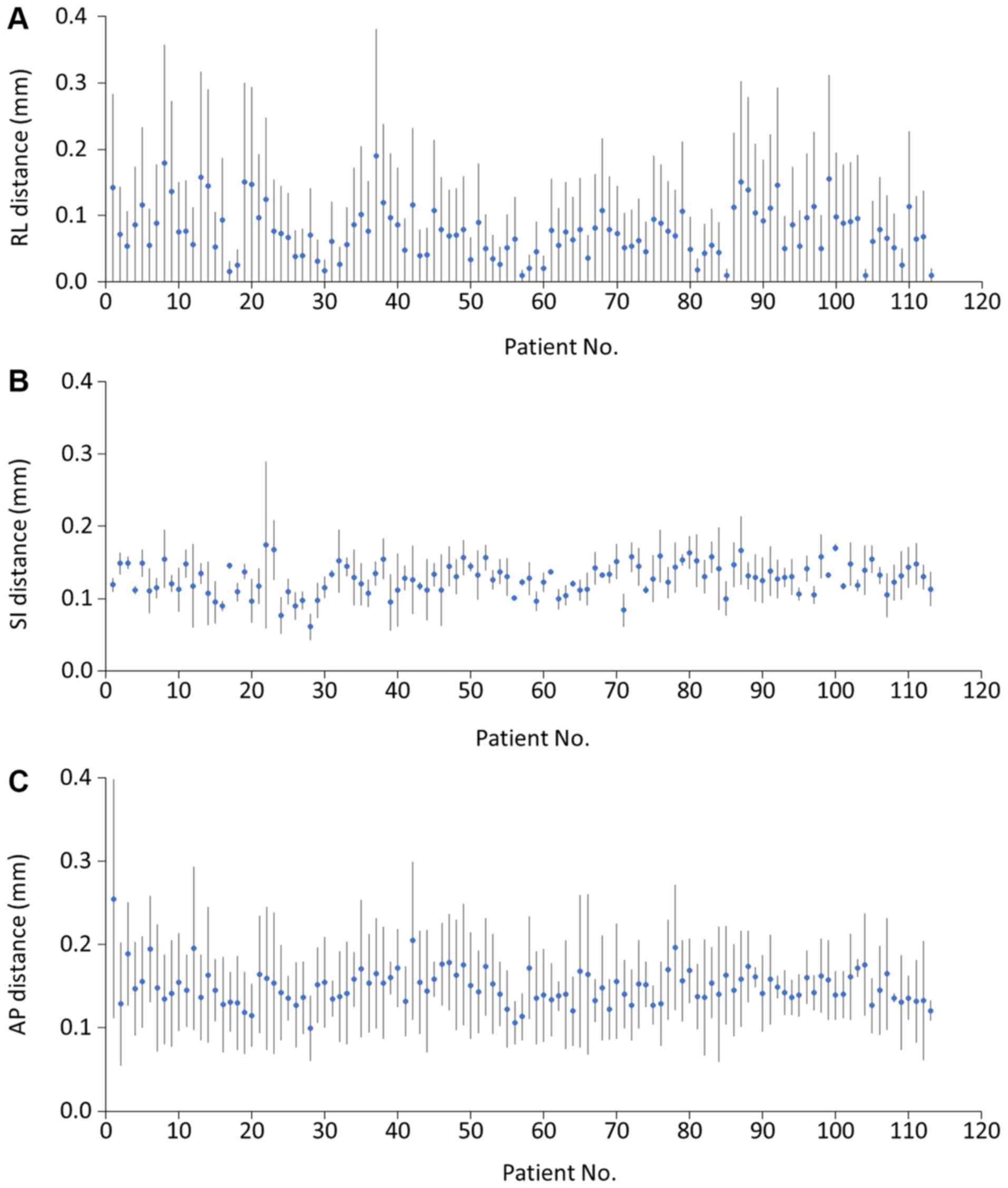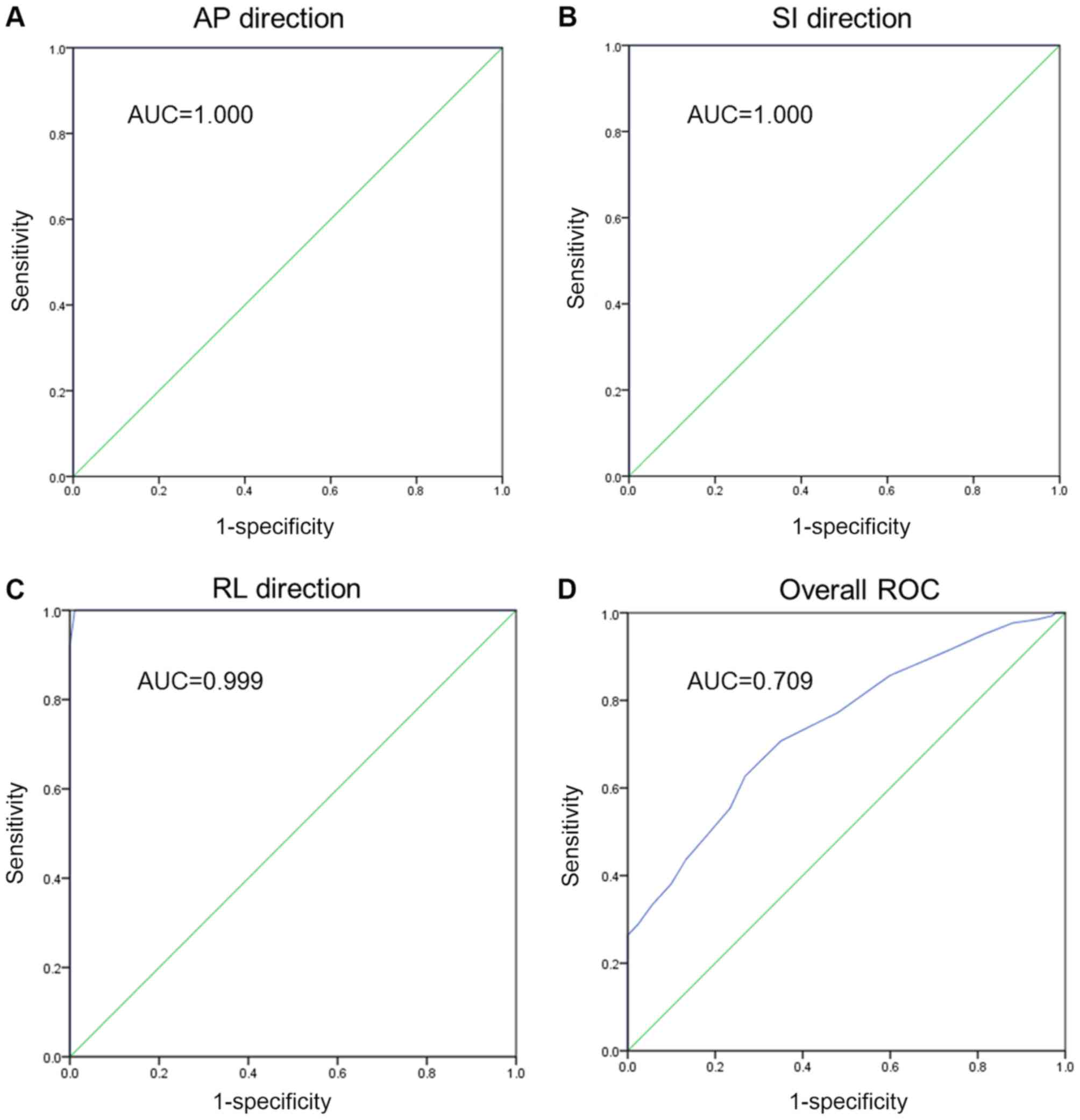|
1
|
Chua MLK, Wee JTS, Hui EP and Chan ATC:
Nasopharyngeal carcinoma. Lancet. 387:1012–1024. 2016. View Article : Google Scholar : PubMed/NCBI
|
|
2
|
Lo KW, Chung GT and To KF: Deciphering the
molecular genetic basis of NPC through molecular, cytogenetic, and
epigenetic approaches. Semin Cancer Biol. 22:79–86. 2012.
View Article : Google Scholar : PubMed/NCBI
|
|
3
|
Zhong H and Chen G, Lin D and Chen G:
Comparison of side effects of intensity modulated radiotherapy and
conventional radiotherapy in 69 cases with nasopharyngeal
carcinoma. Lin Chung Er Bi Yan Hou Tou Jing Wai Ke Za Zhi.
27:462–464. 2013.(In Chinese). PubMed/NCBI
|
|
4
|
Han C, Chen YJ, Liu A, Schultheiss TE and
Wong JY: Actual dose variation of parotid glands and spinal cord
for nasopharyngeal cancer patients during radiotherapy. Int J
Radiat Oncol Biol Phys. 70:1256–1262. 2008. View Article : Google Scholar : PubMed/NCBI
|
|
5
|
Zhang X, Li M, Cao J, Luo JW, Xu GZ, Gao
L, Yi J, Huang X, Xiao J, Li S and Dai J: Dosimetric variations of
target volumes and organs at risk in nasopharyngeal carcinoma
intensity-modulated radiotherapy. Br J Radiol. 85:e506–e513. 2012.
View Article : Google Scholar : PubMed/NCBI
|
|
6
|
Boda-Heggemann J, Lohr F, Wenz F, Flentje
M and Guckenberger M: kV cone-beam CT-based IGRT: A clinical
review. Strahlenther Onkol. 187:284–291. 2011. View Article : Google Scholar : PubMed/NCBI
|
|
7
|
Chau RM, Teo PM, Kam MK, Leung SF, Cheung
KY and Chan AT: Dosimetric comparison between 2-dimensional
radiation therapy and intensity modulated radiation therapy in
treatment of advanced T-stage nasopharyngeal carcinoma: To treat
less or more in the planning organ-at-risk volume of the brainstem
and spinal cord. Med Dosim. 32:263–270. 2007. View Article : Google Scholar : PubMed/NCBI
|
|
8
|
van Herk M, Remeijer P, Rasch C and
Lebesque JV: The probability of correct target dosage:
Dose-population histograms for deriving treatment margins in
radiotherapy. Int J Radiat Oncol Biol Phys. 47:1121–1135. 2000.
View Article : Google Scholar : PubMed/NCBI
|
|
9
|
Wilkinson JM: Geometric uncertainties in
radiotherapy. Br J Radiol. 77:86–87. 2004. View Article : Google Scholar : PubMed/NCBI
|
|
10
|
Chinese committee for staging of
nasopharyngeal carcinoma report on revision of the Chinese 1992
staging system for nasopharyngeal carcinoma. Radiation Oncol.
2:233–240. 2013. View Article : Google Scholar
|
|
11
|
DICOM, . Scope and Field of Application.
http://dicom.nema.org/medical/dicom/current/output/chtml/part01/chapter_1.htmlJune
12–2017
|
|
12
|
Su J, Chen W, Yang H, Hong J, Zhang Z,
Yang G, Li L and Wei R: Different setup errors assessed by weekly
cone-beam computed tomography on different registration in
nasopharyngeal carcinoma treated with intensity-modulated radiation
therapy. OncoTargets and Ther. 8:2545–2553. 2015.
|
|
13
|
Stroom JC and Heijmen BJ: Geometrical
uncertainties, radiotherapy planning margins, and the ICRU-62
report. Radiother Oncol. 64:75–83. 2002. View Article : Google Scholar : PubMed/NCBI
|
|
14
|
Zweig MH and Campbell G:
Receiver-operating characteristic (ROC) plots: A fundamental
evaluation tool in clinical medicine. Clin Chem. 39:561–577.
1993.PubMed/NCBI
|
|
15
|
Tan W, Li Y, Han G, Xu J, Wang X, Li Y and
Hu D: Target volume and position variations during
intensity-modulated radiotherapy for patients with nasopharyngeal
carcinoma. Onco Targets Ther. 6:1719–1728. 2013. View Article : Google Scholar : PubMed/NCBI
|
|
16
|
Chen AM, Farwell DG, Luu Q, Donald PJ,
Perks J and Purdy JA: Evaluation of the planning target volume in
the treatment of head and neck cancer with intensity-modulated
radiotherapy: What is the appropriate expansion margin in the
setting of daily image guidance? Int J Radiat Oncol Biol Phys.
81:943–949. 2011. View Article : Google Scholar : PubMed/NCBI
|
|
17
|
Hurkmans CW, Remeijer P, Lebesque JV and
Mijnheer BJ: Set-up verification using portal imaging; review of
current clinical practice. Radiother Oncol. 58:105–120. 2001.
View Article : Google Scholar : PubMed/NCBI
|
|
18
|
Zhang L, Garden AS, Lo J, Ang KK, Ahamad
A, Morrison WH, Rosenthal DI, Chambers MS, Zhu XR, Mohan R and Dong
L: Multiple regions-of-interest analysis of setup uncertainties for
head-and-neck cancer radiotherapy. Int J Radiat Oncol Biol Phys.
64:1559–1569. 2006. View Article : Google Scholar : PubMed/NCBI
|
|
19
|
Cheo T, Loh Y, Chen D, Lee KM and Tham I:
Measuring radiotherapy setup errors at multiple neck levels in
nasopharyngeal cancer (NPC): A case for differential PTV expansion.
Radiother Oncol. 117:419–424. 2015. View Article : Google Scholar : PubMed/NCBI
|
|
20
|
van Kranen S, van Beek S, Rasch C, van
Herk M and Sonke JJ: Setup uncertainties of anatomical sub-regions
in head-and-neck cancer patients after offline CBCT guidance. Int J
Radiat Oncol Biol Phys. 73:1566–1573. 2009. View Article : Google Scholar : PubMed/NCBI
|
|
21
|
Djordjevic M, Sjöholm E, Tullgren O and
Sorcini B: Assessment of residual setup errors for anatomical
sub-structures in image-guided head-and-neck cancer radiotherapy.
Acta Oncol. 53:646–653. 2014. View Article : Google Scholar : PubMed/NCBI
|
|
22
|
Polat B, Wilbert J, Baier K, Flentje M and
Guckenberger M: Nonrigid patient setup errors in the head-and-neck
region. Strahlenther Onkol. 183:506–511. 2007. View Article : Google Scholar : PubMed/NCBI
|
|
23
|
Ove R, Cavalieri R, Noble D and Russo SM:
Variation of neck position with image-guided radiotherapy for head
and neck cancer. Am J Clin Oncol. 35:1–5. 2012. View Article : Google Scholar : PubMed/NCBI
|
|
24
|
Li H, Zhu XR, Zhang L, Dong L, Tung S,
Ahamad A, Chao KS, Morrison WH, Rosenthal DI, Schwartz DL, et al:
Comparison of 2D radiographic images and 3D cone beam computed
tomography for positioning head-and-neck radiotherapy patients. Int
J Radiat Oncol Biol Phys. 71:916–925. 2008. View Article : Google Scholar : PubMed/NCBI
|
|
25
|
Wang J, Bai S, Chen N, Xu F, Jiang X, Li
Y, Xu Q, Shen Y, Zhang H, Gong Y, et al: The clinical feasibility
and effect of online cone beam computer tomography-guided
intensity-modulated radiotherapy for nasopharyngeal cancer.
Radiother Oncol. 90:221–227. 2009. View Article : Google Scholar : PubMed/NCBI
|
|
26
|
Mongioj V, Orlandi E, Palazzi M, Deponti
E, Marzia F, Stucchi C, Sangalli C, Fallai C, Zonca G, Olmi P and
Pignoli E: Set-up errors analyses in IMRT treatments for
nasopharyngeal carcinoma to evaluate time trends, PTV and PRV
margins. Acta Oncol. 50:61–71. 2011. View Article : Google Scholar : PubMed/NCBI
|
|
27
|
Dionisi F, Palazzi MF, Bracco F, Brambilla
MG, Carbonini C, Asnaghi DD, Monti AF and Torresin A: Set-up errors
and planning target volume margins in head and neck cancer
radiotherapy: A clinical study of image guidance with on-line
cone-beam computed tomography. Int J Clin Oncol. 18:418–427. 2013.
View Article : Google Scholar : PubMed/NCBI
|
|
28
|
Kapanen M, Laaksomaa M, Tulijoki T,
Peltola S, Wigren T, Hyodynmaa S and Kellokumpu-Lehtinen PL:
Estimation of adequate setup margins and threshold for position
errors requiring immediate attention in head and neck cancer
radiotherapy based on 2D image guidance. Radiat Oncol. 8:2122013.
View Article : Google Scholar : PubMed/NCBI
|
|
29
|
Anjanappa M, Rafi M, Bhasi S, Kumar R,
Thommachan KC, Bhattacharya T and Ramadas K: Setup uncertainties
and PTV margins at different anatomical levels in intensity
modulated radiotherapy for nasopharyngeal cancer. Rep Pract Oncol
Radiother. 22:396–401. 2017. View Article : Google Scholar : PubMed/NCBI
|
|
30
|
Kron T: Reduction of margins in external
beam radiotherapy. J Med Phys. 33:41–42. 2008. View Article : Google Scholar : PubMed/NCBI
|


















